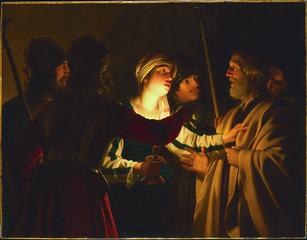AphroditeGoneAwry
failure to thrive
- Joined
- Feb 20, 2009
- Messages
- 5,585
- MBTI Type
- INfj
- Enneagram
- 451
- Instinctual Variant
- sx/so

Gerrit van Honthorst, The Denial of Saint Peter, c. 1620, oil on canvas, Minneapolis Institute of Arts.

Giovanni Baglione. Sacred and Profane Love. 1602–1603, showing dramatic compositional chiaroscuro

The Stag Hunt mosaic (c. 300 BCE) by gnosis epoesen, or 'knowledge did it'. is a mosaic from a wealthy home of the late 4th century BC, the so-called "House of the Abduction of Helen" (or "House of the Rape of Helen")
The Stag Hunt (just above) is one of the first examples of chiaroscuro in the ancient world that is still preserved. The contrast between light and dark was an invention of the western Greeks called 'skiagraphia' or "shadow-painting" and used in paintings (which are lost), and mosaics. It was later refined in the middle ages into the Italian paintings as seen farther above, becoming more popularly known as 'chiaroscuro' or "light-dark".
I first became aware of chiaroscuro while browsing the Minneapolis Art Institute. I still remember the Italian Renaissance room, and what really drew me in was the pearly white paint on the canvas, contrasted against the nearly black background. I am not sure what they used in their white paint, but viewing it in person is very moving and effective. The only other thing that really affected me at that art museum were the alabaster and white marble sculptures. Something about opalescent white objects draws me in and mesmerizes me. I prefer the stone to be almost translucent near the edges, as it beckons you to try to peer deeper inside it.
I still did not know that what I was enjoying in these paintings had a characteristic name, so when I discovered that a few years ago, another piece of my puzzle fell into place. I realized then that this is why my favorite painting of my mother's has always been this one: it has chiaroscuro elements and a large area of pearlescent white in the coffee pot:
I suppose if we wanted to analyze it further, we could say this art form appeals because it forces our perspective into black and white thinking, something the world doesn't really lend itself to very often due to its shades of grey. Is it a juvenile mind that wants to think of the world and people in extremes of all good and all bad, all light and all dark? Or is it an actual truth of God that things are really either good, or they are bad. Jesus refers to this chiaroscuric thinking several times in His teachings, "If you are lukewarm I will spit you out," and "If you are not for me, you are against me."
All I know is it appeals to my sense of all or nothing~
I invite you all to post your favorite chiaroscuro art, if you like.

